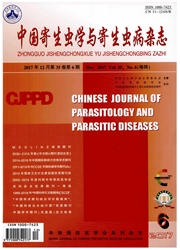

 中文摘要:
中文摘要:
目的观察C57BL/6小鼠感染日本血吸虫后肠系膜淋巴结Th17细胞的免疫应答。方法20只C57BU6小鼠随机分为感染组和对照组.每组10只,感染组小鼠经腹部皮肤感染日本血吸虫尾蚴,每鼠(40+5)条。感染后5-6周分离小鼠肠系膜淋巴结的淋巴细胞,分别用抗小鼠CD3单克隆抗体(anti-CD3,1μg/m1)和抗小鼠CD28单克隆抗体(anti-CD28,1μg/ml)刺激,培养4h后收集细胞,RT-PCR检测小鼠肠系膜淋巴结淋巴细胞中自细胞介素17(IL-17)和维甲酸相关孤独受体(ROR-γt)mRNA的转录水平;培养72h后,ELISA检测细胞培养上清液IL-17和1干扰素(IFN-1)的含量。同时用佛波酯(PMA,10ng/m1)和离子霉素(1μg/ml)刺激淋巴细胞5h后,胞内细胞因子染色,流式细胞术检测Th17细胞的含量和其他细胞因子的产生。结果ELISA检测结果显示,感染小鼠肠系膜淋巴结培养物上清液中IFN-γ[(214.3±62.6)pg/ml]和IL-17[(176.8±62.1)pg/ml]的含量明显高于健康小鼠[(46.7±13.9)和0pg/ml](P〈0.05)。RT-PCR检测结果显示,IL-17和ROR-γt mRNA转录水平也明显高于健康小鼠。感染小鼠肠系膜淋巴细胞CD4+T细胞中,Th17细胞的比例为(0.55±0.03)%,明显高于健康小鼠[(0.16±0.01)%](只以05)。在CD4+T细胞中,IL-17+ IL4+细胞占0.06%,IL-17+IFNγt和IL-17+IL5+细胞各占0.02%,IL-17+ IL-9+细胞占0.01%,未检测到Tl-17+IL-10+和IL-17+Foxp3+细胞。结论日本血吸虫感染C57BIJ6小鼠的肠系膜淋巴结能诱导Th17细胞产生。Th17细胞能分泌IL-4,及少量的IFN-γ、IL5和IL-9,不分泌IL-10,也不表达Foxp3。
 英文摘要:
英文摘要:
Objective To observe the immune response of Th17 cells in mes'enteric lymph node (MLN) of C57BL/6 mice infected by Schistosoma japonicum. Methods Twenty C57BL/6 mice were randomly divided into infected group and control group each with ten mice. The mice in infected group were infected each with 40±5 S. japonicum cercariae. Five to six weeks later, MLN lymphocytes were separated and stimulated for 4 h by anti-CD3 (1μg/ml) and anti-CD28 (1μg/ml) before examination of IL-17 and retinoic acid receptor-related orphan receptor γt (ROR-γt) mRNA by reverse transcription PCR. The level of IL-17 and IFN-γ was detected by ELISA after culturing with supernatant for 72 h. MLN lymphoeytes were stimulated for 5 h by 10ng/ml phorbol myristoyl acetate (PMA) and 1 μg/ml ionomycine. The intracellular cytokines were stained and the content of Thl7 and other cytokines was examined by flow cytometry. Results The level of IFN-γ[(214.3±62.6) pg/ml] and IL-17 [(176.8±62.1) pg/ml] in the supernatant of culured MLN cells from the infected mice was significantly higher than that of normal mice [(46.7±13.9) and 0 pg/ml)(P〈0.05). The expression level of IL-17 and ROR-γt mRNA was also considerably higher than that of normal mice. IL-17+ IL-4+, IL-17+IFN-γt, IL-17+ IL-5+ and IL-17+ IL-9 cells accounted for 0.06%, 0.02%, 0.02%, and 0.01% of the mesenteric lymph node CD4+ T cells of the infected mice, respectively. However, IL-17+ IL-10+ and IL-17+ Foxp3+ cells were undetected. Conclusion The MLN of S. japonicum-infected C57BL/6 mice can induce the production of Thl7 cells, and these cells can secrete IL-4, less IFN-γ, IL-5 and IL-9, but not IL-10, and can not express Foxp3 in the infected mice.
 同期刊论文项目
同期刊论文项目
 同项目期刊论文
同项目期刊论文
 期刊信息
期刊信息
